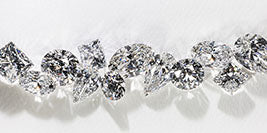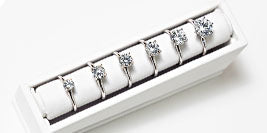Since Leonardo DiCaprio popularized "Blood Diamonds" in 2006, efforts to combat their trade have progressed, but challenges persist. Despite a massive $89 billion industry, with 65% of diamonds sourced from Africa, corruption and violence have plagued the region.
Although strides have been made, exploitation remains rampant. Consumers must research and inquire to avoid supporting this unethical trade. A recent Human Rights Watch report on major jewelry and watchmakers revealed inadequate oversight, with most failing to ensure ethical diamond sourcing.
No company received an "excellent" rating, highlighting the ongoing need for transparency and accountability in the diamond industry.
Photo Credit: Getty Images
#1: The Kimberley Process Is B.S.
If you ask about blood diamonds in a jewelry store (as the amazing conscious consumer that you are!) you will probably get a reply like “Don’t worry, our diamonds are certified by the Kimberley Process Certification Scheme”. But most consumers don’t really know what it means, and most earth-mined jewelers like it that way.
One of the main outcomes of the social outcry against the conflict diamond trade was the Kimberley Process Certification Scheme (KPCS), established in 2003. The purpose of the KPCS is to reduce “the flow of conflict diamonds ⏤ ‘rough diamonds used to finance wars against governments.’”
However, the main problem with the KPCS is that the definition of a conflict diamond is far too narrow. It merely aims to end revenue from diamonds going to rebel groups to fund wars. However, it does nothing to address corrupt governments, state-sponsored militias, or the unethical treatment of people involved in the process of mining blood diamonds. This means someone could still have been enslaved, tortured, raped, beaten, or killed to mine that diamond, and it is marketed as a conflict-free diamond because it didn’t directly fund a war.
Some African officials equate diamond mining and the Kimberley Process to slavery. They urge people to acknowledge the colonialism and oppression of the African miners by European mine owners. Penny Hess, Chairperson of the African People’s Solidarity Committee said,
“[The] Kimberley [Process] is nothing more than an attempt to conserve the diamond trade, which is unethical at its core. It merely qualifies the operation of a genocidal industry which helps to maintain the specter of European colonialism in Africa.”
The article on blood diamonds points to De Beers, who “have exploited the Kimberley mechanism as a way of preserving the longevity of the diamond trade, despite a myriad of human rights concerns.”
This is one of the main reasons MiaDonna and the Greener Diamond Foundation were created in 2005. We made it paramount to redefine the definition of a conflict diamond to any diamond that is not sustainable and therefore negatively impacting humanity and or the environment.
Photo Credit: Getty Images
#2: Trouble In Central African Republic (CAR)
Another issue with the KPCS is that a certification does not apply to a specific diamond but to a group of diamonds. A major problem with the conflict diamond trade is that smuggled diamonds can be easily mixed with other mined diamonds and then the whole ground is certified as conflict-free, even though they are actually blood diamonds.
This is common practice in the Central African Republic (CAR). In 2013, diamonds from the CAR were banned under the Kimberley Process. Despite these sanctions, it is estimated that upwards of twenty four million dollars worth of diamonds have been smuggled out of CAR. A Reuters article from February 2020 said,
“Current restrictions [by the KPCS] have not affected CAR’s total output of diamonds. Instead, it has increased the amount of diamonds sold illegally and generated profits for middlemen rather than local communities.”
#3: Issues in Meringue, Zimbabwe
Last fall, the United States government banned the importing of diamonds from Marange, Zimbabwe, because they were “produced, in whole or in part, using forced labor.”
It is well documented that people living near the mines have faced forced labor, torture, and other humanitarian abuses because of the conflict diamond trade. Prior to 2016, there were several mining companies operating in the Marange Mines. All but one of those companies has been forced out by the country’s president.
Now, only ‘Zimbabwe Consolidated Diamond Company’, which is owned by the government, is mining blood diamonds in the area. The authorities have declared the area a “protected area,” and visitors must get special permission to enter. Anyone caught without documentation proving residency is arrested. And anyone presumed to be illegally mining in the area is captured and tortured or killed, often with dogs trained to maul.
To make way for the mines, more than 1,000 families were forcefully removed from their homes and relocated to a government-owned farm about 25 miles north. They were given great promises of new homes, healthcare, shops, and education in exchange for relocating. In reality, the families got sheds, and often go hungry due to a lack of food. They are still waiting for the promised healthcare and schools that never materialize.
Keep in mind that until the ban in October 2019, diamonds from Marange were certified conflict-free because they were not being used to fund a rebel war. The KPCS does not consider humanitarian abuses or funding corrupt governments during wars, only rebel forces.
Photo Credit: Stop Blood Diamonds
#4: The Abuse of Artisanal Miners
There are approximately 1.5 million artisanal miners, or small scale miners not employed by a mining company, that account for 20% of the mined diamonds. These miners are not regulated and are often responsible for environmental, health, and human rights abuses. These diamonds are also easily mixed into “clean” diamonds despite the lack of oversight.
Countries like Zimbabwe are notorious for killing, raping, and maiming hundreds of artisanal miners. Besides the institutionalized violence, artisanal miners are also at a greater risk of injury or death because they lack equipment and safety regulations. One reporter followed a group of artisanal miners in the Democratic Republic of the Congo who were mining for diamonds in the River Kwango. They used handmade, stitched together wetsuits and old house pipes as a way to get air to the divers. In many countries, children can be seen in the mines trying to earn money for their families instead of being in school. It’s a vicious cycle that is extremely difficult to break out of. Unfortunately, the big pay off artisanal miners are looking for is a fraction of the value of the diamonds they find. A 1.0ct diamond will only get the miner about 100 dollars. Artisanal Miners may go months without finding even the smallest diamond.
The environment also suffers at the hands of artisanal miners. Since they are not regulated, oftentimes they use chemicals such as Mercury to extract the Kimberlite and rough diamonds which then seeps into the groundwater and soil.
Photo Credit: Global Witness
#5: Russia's Involvement in the Diamond Industry
Russia is making news in the diamond industry for two reasons: its relationship with mining in the Central African Republic (CAR) and its attempt to lift a Kimberley Process sanction preventing the sale of diamonds from CAR. Russia is working hard to establish roots in Africa, with a particular interest in CAR. This relationship is being managed by Yevgeny Prigozhin, a Putin administrator (who used to be Putin’s chef) and who has mercenary ties.
CNN reported “Prigozhin’s conglomerate includes a company called Lobaye Invest that funds the radio station in the Central African Republic (CAR). It also finances the training of army recruits in the CAR by some 250 Russian mercenaries, with more on the way. The dividend for Lobaye Invest: generous concessions to explore for diamonds and gold in a country rich in mineral wealth.” The United States has had its eye on Prigozhin for a while and indicted him for funding Russia’s involvement in the 2016 presidential election.
The diamonds Russia is after are currently illegal to sell based on sanctions from the Kimberley Process that were issued in 2013. Russia becomes the rotating chair of the Kimberley Process this year. Their plan is to bring a vote to remove the CAR restrictions. They have already successfully moved to have diamonds KPS certified that are mined from “Green Zones” that are run by the government. So far 39,000 carats form the Green Zones have successfully been registered and sold. If Russia succeeds in removing all the sanctions, the value of the diamonds in the country will skyrocket. Thankfully, the U.S. and European Union have vowed to vote against lifting the embargo.
Photo Credit: Global Witness
#6: Canadian Diamonds Are Conflict Diamonds
Some major diamond mining companies are labeling diamonds from Canada as conflict-free. It's a great marketing tactic, but simply not true. Diamonds mined from Canada do not have the same level as human rights abuses like Russia or Africa, but like all diamond mining, it is incredibly detrimental to the environment. De Beers’ Victor Mine in Ontario, Canada, dried up and closed in 2019.
Environmental watch groups have filed a lawsuit against De Beers, alleging they did not report on the extreme mercury levels in five of the nine water testing stations. They are also finding the introduction of calcium and other toxic chemicals from the mining process had a major effect on aquatic life and sections of the food chain. The local tribe in the area is concerned about unemployment and maintaining the infrastructure now that De Beers has pulled out of the area. De Beers spent five million dollars a year to maintain an ice road during the winter season. The tribe can not afford to spend that amount of money and worries about future access to the community.
On land, native animal populations, such as grizzly bears and caribou, have declined since the mine was established and it's only getting worse. Diamond mines are drying up everywhere in the world but especially in Canada. This means mining companies are going into more remote and fragile ecosystems to find diamonds, creating more damage than they ever have before.
Photo Credit: De Beer’s Canada
What You Can Do (You Are The Solution)
MiaDonna and the Greener Diamond Foundation was founded by a one time earth-mined diamond consumer, who unintentionally purchased a blood diamond. To make things right she set out to put the diamond industry on a more sustainable path and pioneered the lab-grown diamond industry as a solution.
Since 2005 we have been advocates for the diamond miner, the environment and the diamond consumer, you! Don’t believe the lies by big business to make a sale. Blood diamond trade is still active. An estimated 1 in 4 diamonds on the international diamond market have been mined under horrific conditions.
Remember as a conscious consumer, you hold the power! You can use your economic power. The most important thing you can do to avoid buying blood diamonds is to research where to get truly ethical jewelry.
If conscious consumers demand that companies align with their values, we may move the needle on the mining industry. Be sure to ask how they certify that their diamonds are conflict-free (and don’t accept the Kimberley Process as an answer). Ask about the country of origin of the diamond, and remember that no diamond coming from the earth can be considered truly conflict-free.
Learn more about our global impact by visiting The Greener Diamond Foundation. And if you want to buy the most ethical diamonds in the world, shop our Lab Grown Diamond Enagement Rings.





























